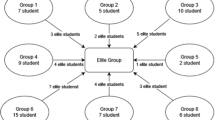Abstract
This paper investigates the effect to ensemble teaching learning-based optimization (TLBO) with other meta-heuristics methods like artificial bee colony (ABC), biogeography-based optimization (BBO), differential evolution (DE) and genetic algorithm (GA). Three different schemes to generate sub-population from the main population are proposed, and the effect of migration of solutions from one sub-population to the other is also explored. The experiments are performed on different unconstrained and constrained benchmark optimization problems. The results are investigated using the statistical test like Friedman rank test and Holm-Sidak post hoc test. The results reveal that the ensemble of different optimization methods is effective than the basic algorithms.
Access this chapter
Tax calculation will be finalised at checkout
Purchases are for personal use only
Similar content being viewed by others
References
Alba E, Troya JM (1999) A survey of parallel distributed genetic algorithms. Complexity 4(4):31–52
Basturk B, Karaboga D (2006) An artificial bee colony (ABC) algorithm for numeric function optimization. In: IEEE Swarm Intelligence Symposium, Indianapolis, Indiana, USA, 12–14 May
Cantú-Paz E (1998) A survey of parallel genetic algorithms. Calc Paralleles Reseauxet Syst Repartis 10(2):141–171
Cavicchio DJ (1970) Adaptive search using simulated evolution. Doctoral Dissertation, University of Michigan, Ann Arbor
Deb K, Pratap A, Agarwal S, Meyarivan TAMT (2002) A fast and elitist multiobjective genetic algorithm: NSGA-II. IEEE Trans Evol Comput 6(2):182–197
Dilettoso E, Salerno N (2006) A self-adaptive niching genetic algorithm for multimodal optimization of electromagnetic devices. IEEE Trans Magn 42:1203–1206
Gan J, Warwick K (1999) A genetic algorithm with dynamic niche clustering for multimodal function optimization. In: Proceedings of the 4th international conference on artificial neural nets and genetic algorithms, pp 248–255
Goldberg DE, Richardson JJ (1987) Genetic algorithms with sharing for multimodal function optimization, Genetic algorithms and their application. In: Proceedings of the 2nd international conference on genetic algorithms, pp 41–49
Goldbergand DE, Wang L (1997) Adaptive niching via coevolutionary sharing. Genet Algorithms Evol Strat Eng Comput Sci 21–38
Dunwei G, Fengping P, Shifan X (2002) Adaptive niche hierarchy genetic algorithm. In: TENCON ’02. proceedings of IEEE region 10 conference on computers, communications, control and power engineering, pp 39–42
Harik G (1994) Finding multiple solutions in problems of bounded difficulty. IIIiGAL Report No. 94002, University of Illinois at Urbana-Champaign
Holland J (1975) Adaptation in natural and artificial systems. University of Michigan Press, Ann Arbor
Joaquín D, Salvador G, Daniel M, Francisco H (2011) A practical tutorial on the use of nonparametric statistical tests as a methodology for comparing evolutionary and swarm intelligence algorithms. Swarm Evol Comput 1(1):3–18
Jong KA (1975) An analysis of the behavior of a class of genetic adaptive systems. Doctoral Dissertation, University of Michigan
Karaboga D (2005) An idea based on honey bee swarm for numerical optimization. Technical Report-TR06, Erciyes University, Engineering Faculty, Computer Engineering Department
Karabogaand D, Akay B (2009) Artificial bee colony (ABC), harmony search and bees algorithms on numerical optimization. In: IPROMS-2009, Innovative Production machines and systems virtual conference, Cardiff, UK
Kim JK, Cho DH, Jungand HK, Lee CG (2002) Niching genetic algorithm adopting restricted competition selection combined with pattern search method. IEEE Trans Magn 38(2):1001–1004
Lee C, Choand D-H, Jung H-K (1999) Niching genetic algorithm with restricted competition selection for multimodal function optimization. IEEE Trans Magn 35(3):1722–1725
Li M, Wang Z (2009) A hybrid coevolutionary algorithm for designing fuzzy classifiers. Inf Sci 179(12):1970–1983
Lin C-Y, Wu W-H (2002) Niche identification techniques in multimodal genetic search with sharing scheme. Adv Eng Softw 33(11–12):779–791
Mahfoud SW (1992) Crowding and preselection revisited. Parallel Probl Solving Nat 2:27–37
Mahfoud SW (1995) Niching methods for genetic algorithms. Ph.D. thesis, IlliGAL Report No. 95001, University of Illinois at Urbana-Champaign
Mallipeddi R, Suganthan PN (2010) Ensemble of constraint handling techniques. IEEE Trans Evol Comput 14(4):561–579
Mallipeddi R, Suganthan PN, Pan QK, Tasgetiren MF (2011) Differential evolution algorithm with ensemble of parameters and mutation strategies. Appl Soft Comput 11(2):1679–1696
Miller BL, Shaw MJ (1996) Genetic algorithms with dynamic niche sharing for multimodal function optimization. In: Proceedings of IEEE international conference on evolutionary computation, New York, USA, pp 786–791
Pétrowski A (1996) A clearing procedure as a niching method for genetic algorithms. In: Proceedings of the IEEE international conference on evolutionary computation, New York, USA, pp 798–803
Rao RV, Savsani VJ, Vakharia DP (2011) Teaching-learning-based optimization: a novel method for constrained mechanical design optimization problems. Comput Aided Des 43(3):303–315
Rao RV, Savsani VJ, Vakharia DP (2012) Teaching-learning-based optimization: an optimization method for continuous non-linear large scale problems. Inf Sci 183:1–15
Ray T, Liew KM (2003) Society and civilization: an optimization algorithm based on the simulation of social behaviour. IEEE Trans Evol Comput 7:386–396
Sareni B, Krahenbuhl L (1998) Fitness sharing and niching methods revisited. IEEE Trans Evol Comput 2(3):97–106
Simon D (2008) Biogeography-based optimization. IEEE Trans Evol Comput 12:702–713
Stornand R, Price K (1997) Differential evolution—a simple and efficient heuristic for global optimization over continuous spaces. J Glob Optim 11:341–359
Talatahari S, Azar BF, Sheikholeslami R, Gandomi AH (2012) Imperialist competitive algorithm combined with chaos for global optimization. Commun Nonlinear Sci Numer Simul 17(3):1312–1319
Yin X, Germay N (1993) A fast genetic algorithm with sharing scheme using cluster analysis methods in multi-modal function optimization. In: Proceedings of the international conference on artificial neural nets and genetic algorithms, pp 450–457
Author information
Authors and Affiliations
Corresponding author
Editor information
Editors and Affiliations
Rights and permissions
Copyright information
© 2020 Springer Nature Singapore Pte Ltd.
About this paper
Cite this paper
Patel, J., Savsani, V., Patel, V. (2020). Effect of Combining Teaching Learning-Based Optimization (TLBO) with Different Search Techniques. In: Gupta, V., Varde, P., Kankar, P., Joshi, N. (eds) Reliability and Risk Assessment in Engineering. Lecture Notes in Mechanical Engineering. Springer, Singapore. https://doi.org/10.1007/978-981-15-3746-2_33
Download citation
DOI: https://doi.org/10.1007/978-981-15-3746-2_33
Published:
Publisher Name: Springer, Singapore
Print ISBN: 978-981-15-3745-5
Online ISBN: 978-981-15-3746-2
eBook Packages: EngineeringEngineering (R0)




